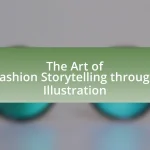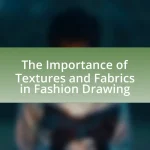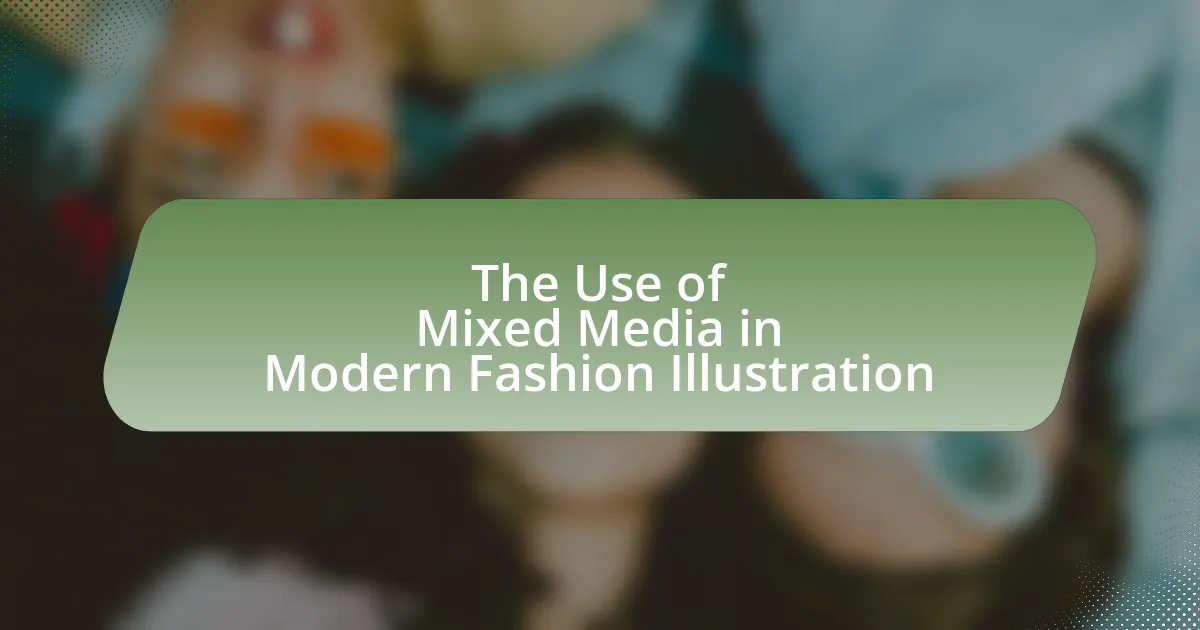The article examines the future of fashion illustration in the context of artificial intelligence (AI), highlighting the evolving collaboration between human artists and AI technologies. It discusses how AI tools streamline design processes, enhance creativity, and democratize access to illustration, allowing for faster production and innovative designs. Key technologies driving these advancements include machine learning algorithms and generative adversarial networks, which enable illustrators to produce unique artwork efficiently. The article also addresses the implications of AI on the roles of human illustrators, the challenges they face, and the ethical considerations surrounding copyright and ownership in AI-generated art. Additionally, it outlines strategies for fashion brands to integrate AI into their design processes while balancing human creativity with technological efficiency.

What is the Future of Fashion Illustration in the Age of AI?
The future of fashion illustration in the age of AI is characterized by increased collaboration between human artists and AI technologies, leading to innovative design processes. AI tools can analyze trends, generate design concepts, and enhance the creative workflow, allowing illustrators to focus on refining their artistic vision. For instance, AI-driven platforms like Daz 3D and Artbreeder enable designers to create unique visuals quickly, which can significantly reduce the time spent on initial drafts. This integration of AI not only streamlines production but also democratizes fashion illustration, making it accessible to a broader audience. As a result, the role of traditional illustrators may evolve into that of curators and collaborators, blending human creativity with AI efficiency to push the boundaries of fashion design.
How is AI transforming traditional fashion illustration?
AI is transforming traditional fashion illustration by automating design processes and enhancing creativity through advanced algorithms. These algorithms can generate unique designs based on trends and consumer preferences, allowing illustrators to focus on more complex creative tasks. For instance, AI tools like DeepArt and Runway ML enable artists to create illustrations quickly by applying styles and generating variations, significantly reducing the time spent on initial drafts. Additionally, AI analyzes vast amounts of data from social media and fashion shows to predict trends, providing illustrators with insights that inform their work. This integration of AI not only streamlines the illustration process but also fosters innovation in design, making it a pivotal element in the evolution of fashion illustration.
What technologies are driving AI advancements in fashion illustration?
AI advancements in fashion illustration are primarily driven by machine learning algorithms, generative adversarial networks (GANs), and computer vision technologies. Machine learning algorithms analyze vast datasets of fashion images to identify trends and styles, enabling the creation of unique illustrations. GANs facilitate the generation of new designs by training on existing artwork, allowing for innovative and diverse outputs. Computer vision technologies enhance the ability to interpret and replicate intricate details in fashion illustrations, improving accuracy and creativity. These technologies collectively enable fashion illustrators to produce high-quality, original artwork efficiently, reflecting the latest trends and consumer preferences.
How do AI tools enhance the creative process for illustrators?
AI tools enhance the creative process for illustrators by automating repetitive tasks and providing innovative design suggestions. These tools enable illustrators to focus more on their artistic vision while leveraging algorithms that can generate variations of designs, suggest color palettes, and even create initial sketches based on input parameters. For instance, AI-driven platforms like Adobe Sensei utilize machine learning to analyze existing artwork and assist in creating new compositions, thereby streamlining the workflow. This integration of AI not only increases efficiency but also inspires creativity by offering new perspectives and ideas that illustrators might not have considered, ultimately leading to more diverse and dynamic illustrations.
What are the implications of AI on the fashion illustration industry?
AI significantly transforms the fashion illustration industry by enhancing creativity, streamlining workflows, and democratizing access to illustration tools. AI-powered software can generate illustrations quickly, allowing artists to focus on conceptualization rather than manual execution. For instance, tools like Adobe’s Sensei utilize machine learning to assist in design processes, enabling faster iterations and more innovative designs. Additionally, AI democratizes fashion illustration by providing accessible platforms for aspiring illustrators, such as Artbreeder, which allows users to create unique designs without extensive training. This shift not only increases productivity but also broadens the diversity of voices in fashion illustration, as more individuals can participate in the creative process.
How does AI influence the role of human illustrators?
AI significantly influences the role of human illustrators by automating repetitive tasks and enhancing creative processes. This technology allows illustrators to focus on more complex and imaginative aspects of their work, as AI tools can generate initial sketches or color palettes quickly. For instance, AI-driven software like Adobe Fresco and Procreate incorporates features that assist artists in creating illustrations more efficiently, thereby streamlining workflows. Additionally, studies indicate that 70% of artists believe AI can augment their creativity rather than replace it, suggesting a collaborative relationship between human illustrators and AI technologies.
What challenges do illustrators face with the rise of AI?
Illustrators face significant challenges with the rise of AI, primarily including job displacement, devaluation of artistic skills, and ethical concerns regarding originality. Job displacement occurs as AI tools can generate illustrations quickly and at a lower cost, leading to reduced demand for human illustrators. The devaluation of artistic skills arises because clients may prioritize AI-generated art for its affordability and speed, undermining the perceived value of traditional illustration techniques. Ethical concerns include issues of copyright and ownership, as AI systems often learn from existing artworks, raising questions about the originality and rights of the original creators. These challenges highlight the need for illustrators to adapt and find new ways to showcase their unique skills in a rapidly evolving landscape.
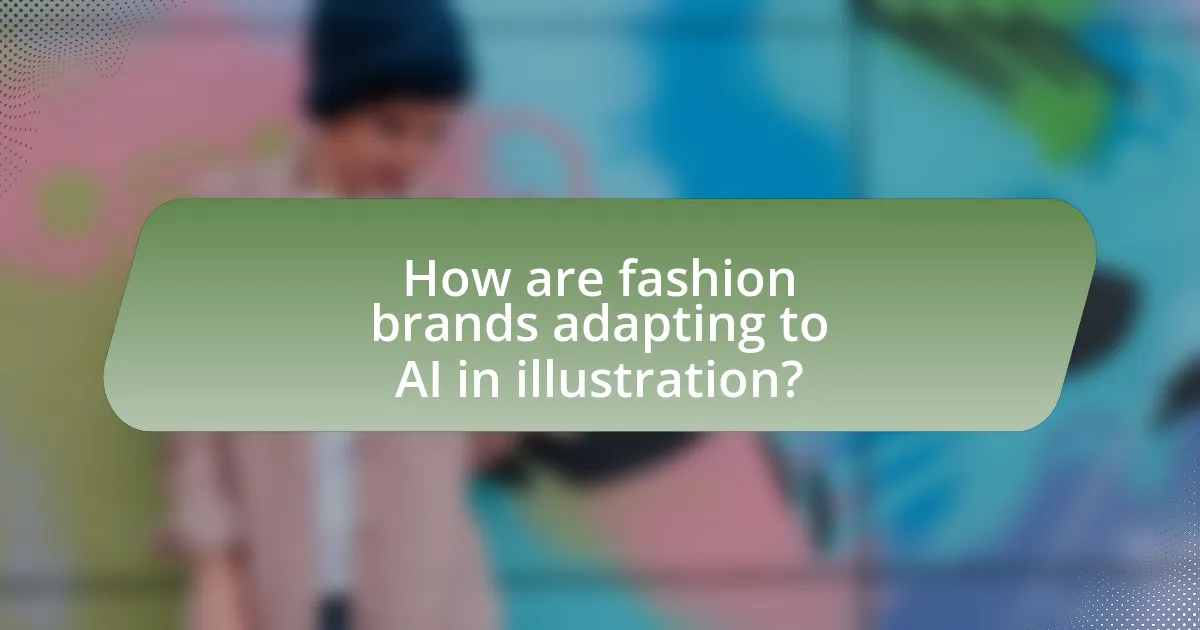
How are fashion brands adapting to AI in illustration?
Fashion brands are adapting to AI in illustration by integrating AI tools to enhance design processes and streamline creative workflows. These brands utilize AI algorithms to generate illustrations, predict trends, and personalize designs based on consumer preferences. For instance, companies like Adidas and Nike have implemented AI-driven design software that allows for rapid prototyping and customization, significantly reducing the time from concept to market. Additionally, AI technologies analyze vast amounts of data to identify emerging fashion trends, enabling brands to stay ahead of the competition and cater to consumer demands more effectively.
What strategies are brands using to integrate AI into their design processes?
Brands are integrating AI into their design processes through strategies such as utilizing generative design algorithms, implementing AI-driven trend analysis, and employing machine learning for customer personalization. Generative design algorithms enable brands to create multiple design variations quickly, optimizing for aesthetics and functionality based on predefined parameters. AI-driven trend analysis allows brands to analyze vast amounts of data from social media and fashion shows, identifying emerging trends and consumer preferences in real-time. Additionally, machine learning algorithms help brands personalize designs and recommendations for individual customers, enhancing user experience and engagement. These strategies are supported by industry reports indicating that AI can reduce design time by up to 50% and improve market responsiveness, demonstrating the effectiveness of AI integration in design processes.
How do brands balance AI-generated content with human creativity?
Brands balance AI-generated content with human creativity by integrating AI tools to enhance efficiency while ensuring that human designers contribute unique artistic insights. This approach allows brands to leverage the speed and scalability of AI for generating initial concepts or variations, while human creativity is essential for refining these ideas, adding emotional depth, and maintaining brand identity. For instance, a study by McKinsey & Company highlights that companies using AI in creative processes see a 20% increase in productivity, but the most successful implementations involve collaboration between AI systems and human talent, ensuring that the final output resonates with consumers on a personal level.
What are the benefits of using AI for fashion marketing and branding?
The benefits of using AI for fashion marketing and branding include enhanced personalization, improved customer insights, and increased efficiency in campaign management. AI algorithms analyze consumer data to tailor marketing strategies, resulting in personalized experiences that resonate with individual preferences. For instance, a study by McKinsey & Company found that personalized marketing can lead to a 10-30% increase in sales. Additionally, AI tools can predict trends and consumer behavior, allowing brands to make data-driven decisions that align with market demands. This predictive capability streamlines campaign management, reducing time and resources spent on ineffective strategies. Overall, AI empowers fashion brands to connect more effectively with their audience while optimizing operational processes.
What trends are emerging in fashion illustration due to AI?
Emerging trends in fashion illustration due to AI include increased personalization, enhanced creativity, and faster production times. AI tools enable illustrators to create customized designs tailored to individual preferences, allowing for a more personalized approach in fashion. Additionally, AI algorithms assist in generating unique styles and concepts, pushing the boundaries of creativity in fashion illustration. Furthermore, AI streamlines the illustration process, significantly reducing the time required to produce high-quality visuals, which is crucial in the fast-paced fashion industry. These trends reflect a shift towards a more efficient and innovative landscape in fashion illustration, driven by advancements in AI technology.
How is AI influencing the styles and techniques used in fashion illustration?
AI is significantly influencing the styles and techniques used in fashion illustration by enabling artists to create more diverse and innovative designs through advanced algorithms and machine learning. These technologies allow for the generation of unique visual styles, as AI can analyze vast datasets of existing illustrations and trends, leading to the emergence of new aesthetics that blend traditional techniques with modern digital capabilities. For instance, AI tools like DeepArt and Runway ML facilitate the transformation of sketches into polished illustrations, enhancing the creative process and allowing illustrators to experiment with various styles quickly. This integration of AI not only streamlines workflows but also democratizes fashion illustration, making it accessible to a broader range of creators who can leverage these tools to express their artistic visions.
What new opportunities are arising for illustrators in the AI landscape?
New opportunities for illustrators in the AI landscape include the ability to leverage AI tools for enhanced creativity and efficiency. AI technologies, such as generative design software and machine learning algorithms, enable illustrators to create unique artwork faster and explore new styles that may not have been possible manually. For instance, AI can analyze trends and suggest design elements, allowing illustrators to stay ahead in the competitive fashion industry. Additionally, platforms that integrate AI can facilitate collaboration between illustrators and brands, streamlining the commissioning process and expanding market reach. These advancements indicate a shift towards a more innovative and collaborative environment for illustrators in the fashion sector.
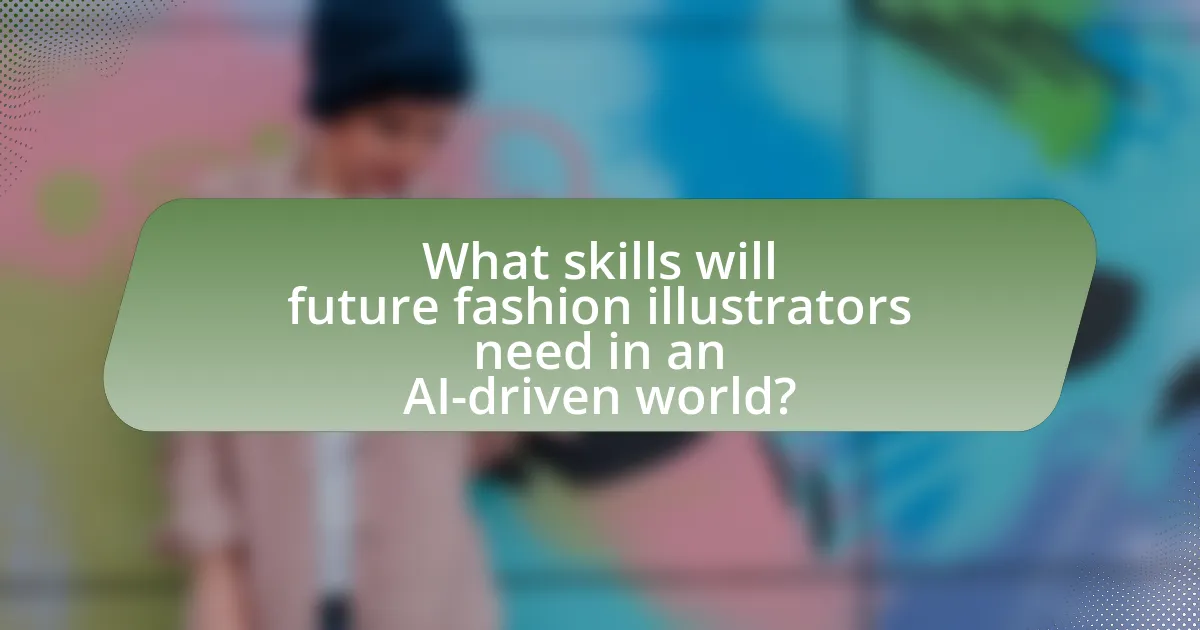
What skills will future fashion illustrators need in an AI-driven world?
Future fashion illustrators will need a combination of technical proficiency in digital tools, creativity, and an understanding of AI technologies. Technical proficiency is essential as illustrators will increasingly rely on software for design and illustration, with tools like Adobe Illustrator and Procreate becoming standard. Creativity remains crucial, as unique artistic vision will differentiate illustrators in a market where AI can generate designs. Understanding AI technologies will also be vital, as illustrators must learn to collaborate with AI systems for tasks like trend analysis and design generation, ensuring their work remains relevant and innovative.
How can illustrators stay relevant in the age of AI?
Illustrators can stay relevant in the age of AI by embracing technology while enhancing their unique artistic voice. By integrating AI tools into their workflow, illustrators can streamline repetitive tasks, allowing them to focus on creativity and innovation. For instance, using AI for color palette generation or composition suggestions can enhance their efficiency. Additionally, illustrators should cultivate a distinct style that sets them apart from AI-generated art, as consumers increasingly value originality and human touch in creative works. According to a 2022 survey by the Creative Industries Federation, 78% of consumers prefer handmade art over digital reproductions, highlighting the importance of personal expression in maintaining relevance.
What technical skills should illustrators develop to work alongside AI?
Illustrators should develop skills in digital illustration software, machine learning basics, and data analysis to effectively work alongside AI. Proficiency in tools like Adobe Illustrator and Procreate enables illustrators to create high-quality digital art that can be enhanced by AI technologies. Understanding machine learning principles allows illustrators to collaborate with AI systems, optimizing workflows and generating innovative designs. Additionally, skills in data analysis help illustrators interpret AI-generated insights, ensuring their artwork aligns with market trends and consumer preferences. These technical skills are essential for illustrators to thrive in the evolving landscape of fashion illustration influenced by AI advancements.
How important is adaptability for illustrators in the evolving industry?
Adaptability is crucial for illustrators in the evolving industry, particularly in the context of fashion illustration influenced by AI advancements. The rapid integration of technology, such as AI-generated art and digital tools, necessitates that illustrators adjust their skills and techniques to remain relevant. For instance, a study by the International Journal of Art and Design Education highlights that artists who embrace new technologies can enhance their creative processes and expand their market reach. This adaptability not only allows illustrators to leverage AI tools for efficiency but also fosters innovation in their artistic expression, ensuring they meet the changing demands of clients and audiences.
What are the ethical considerations of using AI in fashion illustration?
The ethical considerations of using AI in fashion illustration include issues of copyright, authenticity, and the potential for bias. Copyright concerns arise when AI-generated illustrations may inadvertently replicate existing styles or designs, leading to legal disputes over intellectual property. Authenticity is questioned as AI can produce images that may mislead consumers about the origin of the artwork, potentially undermining the value of human creativity. Additionally, bias in AI algorithms can result in the perpetuation of stereotypes or exclusion of diverse representations in fashion, which can harm marginalized communities. These considerations highlight the need for clear guidelines and ethical frameworks to govern the use of AI in this creative field.
How does AI impact copyright and ownership in fashion illustration?
AI significantly impacts copyright and ownership in fashion illustration by complicating the attribution of creative works. As AI-generated illustrations become more prevalent, determining the original creator becomes challenging, raising questions about who holds the copyright—the AI developer, the user who prompted the AI, or the AI itself. Legal frameworks are struggling to keep pace with these advancements; for instance, the U.S. Copyright Office has stated that works created solely by AI without human intervention are not eligible for copyright protection. This creates a legal gray area where traditional notions of authorship and ownership are being redefined, necessitating new guidelines to address the unique challenges posed by AI in the creative industries.
What responsibilities do brands have when using AI-generated illustrations?
Brands have the responsibility to ensure that AI-generated illustrations are ethically sourced and do not infringe on copyright or intellectual property rights. This includes verifying that the datasets used to train AI models do not contain copyrighted material without permission. Additionally, brands must be transparent about the use of AI in their creative processes, informing consumers when illustrations are AI-generated. Ethical considerations also extend to avoiding the perpetuation of biases present in training data, which can lead to misrepresentation or exclusion of certain groups. By adhering to these responsibilities, brands can foster trust and integrity in their use of AI-generated content.
What practical tips can illustrators follow to thrive in the age of AI?
Illustrators can thrive in the age of AI by embracing technology, enhancing their unique style, and focusing on storytelling. By integrating AI tools into their workflow, illustrators can streamline repetitive tasks, allowing them to focus on creativity and innovation. Developing a distinctive artistic voice is crucial, as this uniqueness sets them apart from AI-generated content. Additionally, illustrators should leverage their ability to convey narratives through their work, as storytelling remains a human-centric skill that AI cannot replicate effectively. These strategies are supported by the growing demand for personalized and emotionally resonant art in a market increasingly saturated with automated designs.

